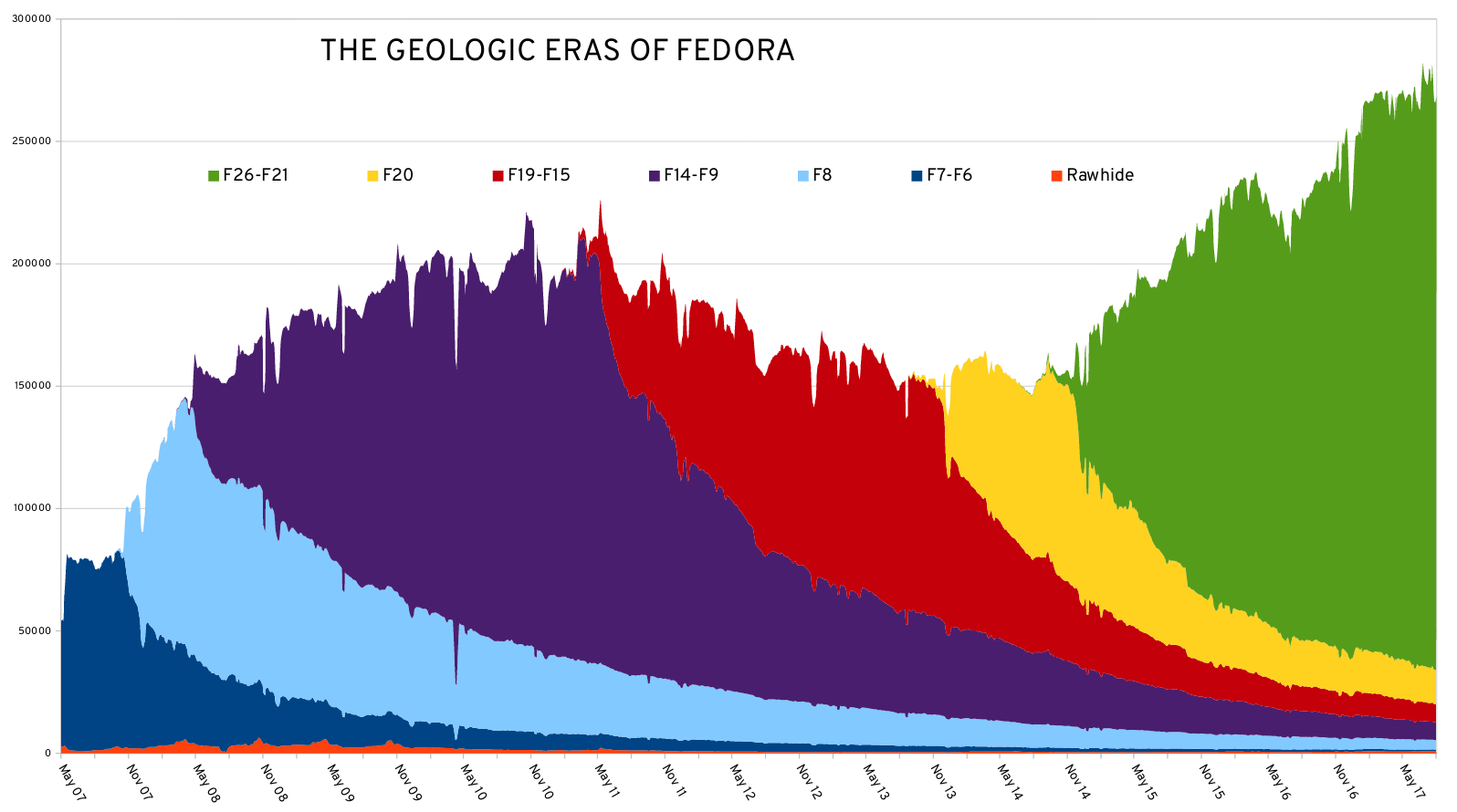Two weeks ago, I had the pleasure to attend Flock 2017, the annual Fedora contributor conference. It moves between North America and Europe and after Krakow, Poland last year it took place in Hyannis, Massachussetts.
The conference started with the traditional keynote by Matthew Miller on the state of the Fedora Project. Matthew does a lot of data mining to create interesting statistics about how the project is doing. The keynote is an opportunity to share it with the public.
The Fedora user base is still growing as you can see on the chart of IP connections to Fedora update servers. Fedora 26 exceeded F25 just before Flock:

Here are also geologic eras of Fedora as Matthew calls them. As you can see there is still a decent number of very old, unsupported Fedora installations which are still alive:

It’s a pity that Matthew didn’t include the slide with ISO download shares of Fedora editions and spins. But last time he did Fedora Workstation amounted to ~80 % of all ISO downloads.
But by far the most popular part of the project is EPEL. Just look at its number of IP connections compared to all Fedora editions:

Which brings me to another interesting talk I attended and that was EPEL State of the Union by a Fedora Project veteran Stephen Smoogen. As a Fedora packager I also maintain a couple of packages for EPEL, so it was interesting to hear how this successful sub-project is doing.
There were not many desktop-related talks this year. No “Status of Fedora Workstation” any more. It was very modularization and infrastructure focused. One of a few desktop talks was “Set up your own Atomic Workstation” by Owen Taylor, who is experimenting with distributing and running Fedora Workstation as an atomic OS, and Patrick Uiterwijk, who has been running it on his machine for a year or so (had a similar talk last year). Wanna try it yourself? Check out https://pagure.io/workstation-ostree-config
Although I didn’t attend the talk about secondary architectures by Dan Horák, we ended up talking and I was very happy to learn that the secondary arch team is doing automated builds of Firefox Nightly to catch problems early. That’s great news for us because with every major release of Firefox secondary architectures consumes a lot of our time. I asked Dan if they could do the same with WebKitGTK+ because it’s a very similar case and it looks like they will!
Several months ago David Labský created a device called Fedorator as his bachelor thesis supervised by a Fedora contributor and Fedora badge champion Miro Hrončok. The device lets you create a bootable USB stick with a Fedora edition of your choice. It’s Raspberry Pi-based, it has a touchscreen. The design is open source and you can assemble it yourself. Two months ago I got an idea to get David to Flock, buy components and assemble a dozen of fedorators which Fedora ambassadors can take home to use at local events. The result of it was a session at Flock where participants indeed assembled a dozen of fedorators. I only provided the idea and connected David with the right people. It wouldn’t have been possible without help of Brian Exelbierd, Paul Frields and others who arranged a budget, bought components etc.

I also did have a session, but unfortunately it was a complete failure 🙁 I coordinate the Fedora Workstation User’s Guide project whose goal is to produce a printed guidebook for new users. We’ve had a Czech version for the last two years and we just finished the English one. I wanted to work on content changes for the next release and help people start versions translated into their languages. Unfortunately my session was scheduled at 6pm on the last day when everyone was ready for dinner or was even leaving the conference. It also overlapped with the docs session which people who I knew had been interested attended.
In the end, not a single person showed up at my session which is my new personal record. I’ve done dozens of talks and sessions at conferences, but zero audience was a new experience.
Anyway, if you’d like to produce a handbook in your language to use at booths and to spread the word about Fedora, check the project on Pagure. As I said the 2017 release is out and will only receive bug fixes, the content is final and thus it’s safe to translate.
Although my session was not really a success I’m still glad I could attend the conference. I had several hallway conversations about the project and countless other interesting conversations, learned new things, caught up with Fedora friends.
Leave a Reply